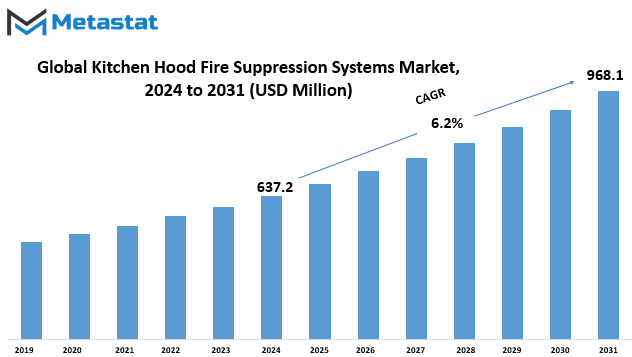MARKET OVERVIEW
The Global Kitchen Hood Fire Suppression Systems market is an integral component within the broader fire safety industry. This sector focuses on innovative solutions tailored to efficiently tackle kitchen fires, underscoring the critical need for advanced fire suppression systems in commercial kitchens worldwide.
As culinary landscapes continue to diversify and evolve, the demand for cutting-edge fire suppression systems has become increasingly pronounced. The Global Kitchen Hood Fire Suppression Systems market addresses the unique challenges posed by kitchen fires, presenting specialized solutions that safeguard both lives and property.
In essence, this market revolves around the development, production, and implementation of advanced fire suppression technologies specifically designed for kitchen environments. These systems are not only responsive but also proactive, employing state-of-the-art mechanisms to swiftly and effectively quell fires originating from cooking appliances and flammable materials commonly found in kitchens.
The industry's primary focus is on creating systems that transcend traditional fire safety measures, recognizing the dynamic and high-risk nature of commercial kitchen settings. From quick-service restaurants to large-scale catering facilities, the Global Kitchen Hood Fire Suppression Systems market tailors solutions to mitigate the specific fire risks inherent in diverse culinary operations.
Innovation remains at the forefront of this industry, with ongoing research and development aimed at refining existing technologies and introducing novel approaches to fire suppression. Engineers and experts within the market constantly strive to enhance system efficiency, responsiveness, and adaptability, ensuring that the installed systems not only meet but exceed safety standards.
The Global Kitchen Hood Fire Suppression Systems market plays a crucial role in fostering a safer environment for both kitchen staff and patrons. Beyond mitigating fire risks, these systems contribute to overall operational continuity, minimizing downtime and potential financial losses associated with fire-related incidents. Consequently, businesses across the hospitality and food service sectors prioritize the integration of advanced fire suppression technologies as an integral part of their risk management strategies.
As regulatory standards become more stringent, the market is responsive to ensuring that its offerings align with global safety requirements. Compliance and adherence to international safety standards are paramount, driving manufacturers and providers within the Global Kitchen Hood Fire Suppression Systems market to uphold the highest quality and reliability in their products and services.
The Global Kitchen Hood Fire Suppression Systems market stands as a critical pillar in the overarching fire safety industry, addressing the unique challenges posed by kitchen fires in commercial settings. With a relentless commitment to innovation, safety, and compliance, this market continues to evolve to meet the ever-changing needs of the dynamic culinary landscape, ensuring that kitchens worldwide are equipped with the most advanced and effective fire suppression solutions available.
Global Kitchen Hood Fire Suppression Systems market is estimated to reach $968.1 Million by 2031; growing at a CAGR of 6.2% from 2024 to 2031.

GROWTH FACTORS
The Kitchen Hood Fire Suppression Systems market is influenced by several factors that shape its dynamics. One of the key drivers propelling its growth is the increasing awareness of fire safety regulations. As people become more conscious of the potential risks associated with kitchen fires, there is a heightened demand for effective solutions to mitigate these dangers.
Another significant driver contributing to the expansion of the market is the growth in the hospitality sector. With a surge in restaurants, hotels, and other hospitality establishments, there is a parallel increase in the need for robust fire suppression systems to ensure the safety of both patrons and property. This trend not only fosters market growth but also underscores the importance of reliable fire safety measures in commercial kitchens.
Despite the positive momentum, the Kitchen Hood Fire Suppression Systems market faces certain constraints. High installation and maintenance costs stand out as a notable restraint, potentially impeding the widespread adoption of these systems. Businesses, especially smaller establishments, may find the financial burden associated with these costs challenging, thus slowing down the market's overall growth.
Another factor hindering the market's seamless progression is the complexity in integrating these systems with existing infrastructure. The challenge lies in ensuring a smooth incorporation of fire suppression technology into kitchens that might already have diverse and complex systems in place. This complexity poses a barrier, necessitating comprehensive solutions that are user-friendly and adaptable to different setups.
Amidst these challenges, there exists a significant opportunity for growth within the Kitchen Hood Fire Suppression Systems market. The prospect lies in the continuous innovation in fire suppression technology. As advancements occur, presenting more efficient and cost-effective solutions, businesses are likely to embrace these innovations, driving market expansion.
Innovation in fire suppression technology opens doors to enhanced safety features, improved efficiency, and potentially lower costs, addressing some of the existing concerns in the market. This presents a positive outlook for the industry, creating an environment where businesses can not only meet fire safety regulations but also do so in a manner that aligns with their financial considerations.
The Kitchen Hood Fire Suppression Systems market is a dynamic landscape shaped by a delicate balance of drivers, restraints, and opportunities. The awareness of fire safety regulations and the growth in the hospitality sector fuel its upward trajectory, while challenges like high installation costs and system integration complexities pose hurdles. Nevertheless, the ongoing innovation in fire suppression technology emerges as a beacon of opportunity, promising a future where safety solutions are not only effective but also accessible to a broader spectrum of businesses.
MARKET SEGMENTATION
By Type
In kitchen safety, the importance of fire suppression systems cannot be overstated. One significant player in this market is the Kitchen Hood Fire Suppression Systems, which comes in different types. These types serve a crucial role in preventing and mitigating fire incidents, making them indispensable in various settings.
The market for Kitchen Hood Fire Suppression Systems is divided into different types, offering a range of options to cater to specific needs. One of the key distinctions lies in the trigger mechanism, with two primary types – Manual Trigger and Thermal Trigger.
The Manual Trigger system puts the control in the hands of the user, allowing them to activate the suppression system manually when needed. This hands-on approach ensures a quick response to potential fire situations, empowering individuals in charge of the kitchen's safety.
On the other hand, the Thermal Trigger system operates based on temperature changes. It automatically activates when a certain temperature threshold is reached, providing a more autonomous response to fire incidents. This type is designed to swiftly and effectively deploy the suppression system without requiring manual intervention.
Both Manual Trigger and Thermal Trigger systems have their advantages, catering to different scenarios and user preferences. The Manual Trigger provides a sense of control, allowing immediate action, while the Thermal Trigger offers automation, ensuring a rapid response even in unattended situations.
The demand for these fire suppression systems has seen a notable increase in recent times, driven by the growing awareness of fire safety measures in commercial and residential kitchens. The market dynamics reflect a heightened emphasis on proactive measures to prevent and manage fire incidents effectively.
In the evolving landscape of kitchen safety, the Manual Trigger and Thermal Trigger systems have become integral components. Their widespread adoption is a testament to the critical role they play in safeguarding lives and property.
As businesses and homeowners alike recognize the paramount importance of fire safety, the Kitchen Hood Fire Suppression Systems market continues to witness growth. The diversity in trigger mechanisms ensures that users can select the system that aligns best with their specific requirements.
The Kitchen Hood Fire Suppression Systems market, with its Manual Trigger and Thermal Trigger variants, stands as a pivotal player in enhancing kitchen safety. As the demand for reliable and efficient fire prevention measures continues to rise, these systems offer a practical and effective solution for a wide range of applications. Their presence is not just a market trend but a reflection of a collective commitment to ensuring a secure and protected kitchen environment.
By Application
The market for Kitchen Hood Fire Suppression Systems plays a crucial role in enhancing safety measures in both residential and commercial settings. One primary application of these systems is found in home kitchens, where the need for fire protection is paramount. Homeowners are increasingly recognizing the importance of installing reliable fire suppression systems to safeguard their properties and loved ones.
Moving on to the commercial kitchen sector, Kitchen Hood Fire Suppression Systems are equally indispensable. Restaurants, cafes, and other food establishments rely on these systems to mitigate the risk of fire incidents. The bustling nature of commercial kitchens, with multiple cooking appliances and continuous operation, heightens the importance of having an effective fire suppression mechanism in place.
These systems are designed to act swiftly and decisively in the event of a fire outbreak. In home kitchens, where families gather and spend valuable time together, the assurance of a reliable fire suppression system brings a sense of security. Meanwhile, in the dynamic environment of commercial kitchens, the swift response of these systems is crucial for preventing extensive damage and ensuring the safety of both the kitchen staff and patrons.
The market is responsive to the diverse needs of both home and commercial kitchen settings. Manufacturers and suppliers recognize the unique requirements of each segment, tailoring their products to cater to specific demands. This adaptability ensures that Kitchen Hood Fire Suppression Systems are not only effective but also compatible with the varied setups they are intended to protect.
Moreover, the increasing awareness of fire safety standards and regulations has contributed to the growing adoption of these systems. Homeowners and business owners alike are realizing that investing in reliable fire suppression is not just a precautionary measure but a necessary component of responsible living and business operation.
The Kitchen Hood Fire Suppression Systems Market, with its focus on applications in home and commercial kitchens, plays a pivotal role in enhancing safety standards. The demand for these systems stems from the shared recognition of the potential risks associated with kitchen environments. As technology advances and safety standards continue to evolve, the market remains a vital player in promoting fire safety, ensuring that both homes and commercial kitchens are equipped to handle unforeseen fire incidents effectively.

REGIONAL ANALYSIS
The Kitchen Hood Fire Suppression Systems Market, categorized by geography, encompasses North America and Europe. These regions play a pivotal role in the global landscape of such safety solutions. North America stands out as a significant player, with its robust infrastructure and stringent safety regulations driving the adoption of Kitchen Hood Fire Suppression Systems.
In North America, the demand for these systems stems from a proactive approach to fire safety. Stringent regulations and a strong emphasis on preventing fire incidents in commercial kitchens contribute to the widespread adoption of fire suppression systems. This trend is not just a regulatory compliance measure but a practical response to safeguarding establishments, reducing risks, and ensuring uninterrupted operations.
Europe, too, shares a similar commitment to fire safety, reflecting a growing awareness of the potential risks associated with kitchen environments. The market for Kitchen Hood Fire Suppression Systems in Europe is fueled by a combination of regulatory frameworks and an increasing understanding among businesses about the need for robust safety measures. As commercial kitchens continue to evolve, the emphasis on safety becomes a priority, driving the demand for advanced fire suppression solutions.
Beyond regulatory compliance, the adoption of these systems is often driven by real-world incidents and the desire to mitigate potential damage. Businesses in both North America and Europe recognize that investing in reliable fire suppression technology is a proactive measure, ensuring the safety of personnel, customers, and assets. The aftermath of a kitchen fire can be devastating, not only in terms of financial losses but also in terms of reputation. Thus, the market for Kitchen Hood Fire Suppression Systems thrives on a collective understanding of the need for preventative measures.
Looking at the global scenario, the emphasis on fire safety is not confined to specific industries but extends across various sectors that utilize commercial kitchens. Restaurants, hotels, educational institutions, and healthcare facilities, among others, recognize the importance of having a robust fire suppression system in place. This universal acknowledgment drives the growth of the Kitchen Hood Fire Suppression Systems market on a global scale.
The global Kitchen Hood Fire Suppression Systems market finds its roots in the practical considerations of safety and risk mitigation. North America and Europe, as key players in this market, showcase a commitment to fire safety that goes beyond mere regulatory compliance. The adoption of these systems is a strategic move by businesses to safeguard their operations and reputation. As the market continues to evolve, the demand for advanced fire suppression solutions is expected to rise, driven by a shared understanding of the critical role these systems play in ensuring a secure and resilient commercial kitchen environment.
COMPETITIVE PLAYERS
The Kitchen Hood Fire Suppression Systems market is a competitive arena with significant players shaping its dynamics. Among the key contenders in this industry are Johnson Controls (Ansul) and Amerex Corporation.
These companies play a pivotal role in the Kitchen Hood Fire Suppression Systems sector, contributing to its overall growth and development. Johnson Controls, known for its Ansul brand, has established itself as a prominent player, bringing expertise and innovation to the table. Similarly, Amerex Corporation is a key participant, contributing to the competitive landscape with its offerings.
The importance of these players lies in their ability to provide effective solutions for fire suppression in kitchen hood systems. In a market where safety is paramount, the role of Johnson Controls and Amerex Corporation becomes crucial. These companies bring a wealth of experience and knowledge, ensuring that their products meet the stringent safety standards prevalent in the industry.
The Kitchen Hood Fire Suppression Systems market thrives on the continuous efforts of these key players to enhance the safety measures in commercial kitchens. Johnson Controls, with its Ansul brand, and Amerex Corporation, contribute to this by developing and delivering reliable fire suppression systems tailored to the unique challenges of kitchen environments.
In the competitive landscape, these companies are not merely participants but influential entities that set benchmarks for quality and performance. Johnson Controls, through Ansul, and Amerex Corporation stand out for their commitment to delivering cutting-edge solutions that address the specific needs of the Kitchen Hood Fire Suppression Systems market.
The competition between these players is not just about market share; it's a race towards ensuring the safety of commercial kitchens. As they vie for prominence, Johnson Controls and Amerex Corporation continually strive to outdo each other in terms of innovation, efficiency, and reliability. This competition benefits end-users, as they can choose from a range of advanced and dependable fire suppression systems.
The Kitchen Hood Fire Suppression Systems market is marked by the active participation of key players such as Johnson Controls (Ansul) and Amerex Corporation. These companies contribute significantly to the industry's growth by providing advanced and reliable solutions for fire safety in commercial kitchens. The competition between them is not just a business rivalry; it's a commitment to ensuring the highest standards of safety in a crucial sector.
Kitchen Hood Fire Suppression Systems Market Key Segments:
By Type
- Manual Trigger
- Thermal Trigger
By Application
- Home Kitchen
- Commercial Kitchen
Key Global Kitchen Hood Fire Suppression Systems Industry Players
- Johnson Controls (Ansul)
- Amerex Corporation
- APS FireCo
- Pyro-Chem
- Halton Group
- A Fire Safety Inc
- Pri-safety Fire Fighting Co.,ltd.
- AKRONEX International Fire Engineering Inc
- CaptiveAire Systems
- Buckeye Fire Equipment
- Reacton Fire Suppression Limited
- Fire Engineering Technology
- Carrier (Kidde Fire Systems)
- Ceasefire Industries Pvt. Ltd.
- Supremex Equipments
WHAT REPORT PROVIDES
- Full in-depth analysis of the parent Industry
- Important changes in market and its dynamics
- Segmentation details of the market
- Former, on-going, and projected market analysis in terms of volume and value
- Assessment of niche industry developments
- Market share analysis
- Key strategies of major players
- Emerging segments and regional growth potential








 US: +1 3023308252
US: +1 3023308252






